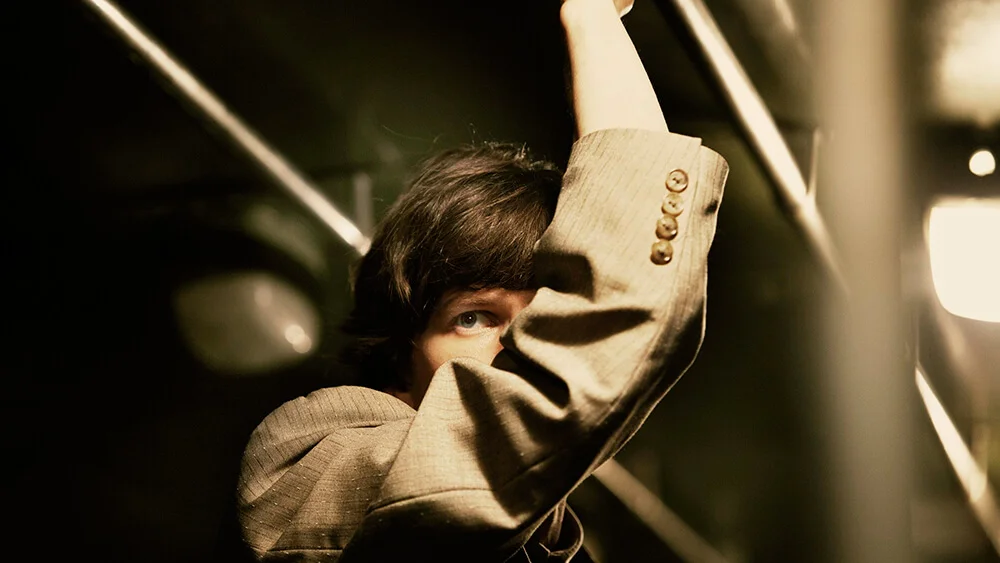Jesse Eisenberg in “The Double”.
By André Crous
Not unlike Denis Villeneuve’s “Enemy”, which was released in the same year, Richard Ayoade’s The Double shows signs of noir, with a lot of the action taking place in yellow-hued, toxic-looking daylight (Enemy) or at night time and inside windowless buildings where the rooms are lit with hard yellow lights (The Double). Also, both stories are adaptations of works by renowned novelists – the former from José Saramago and the latter from Dostoyevsky. The two films are surprisingly similar in tone, with very thin story lines enveloped in a sense of utter hopelessness that, especially in The Double, seems positively Kafkaesque.
Set in an anonymous city at an unknown time in what is more a world of nightmares than that of actual reality (thus differing slightly from the recognisable yet alien Toronto landscape presented in Enemy), Ayoade’s film seems to have borrowed its sombre ambience from Terry Gilliam’s Brazil, with all devices simultaneously appearing to be advancements of and regressions from those of the present day.
The main character here is an awkward, gangly fellow named Simon James (Jesse Eisenberg), who loses his briefcase in the subway when he fails to be assertive. This lack of action pervades the film, and at times the viewer will be thoroughly demoralised by how pathetic he is. But when he arrives at the reception desk of the behemoth that is his workplace, where he has been employed for more than seven years, he discovers that the clerk doesn’t recognise him without his ID card. In fact, he slowly realises he is mostly invisible to those around him.
But then, something extraordinary happens. A fellow who looks and dresses exactly like him arrives. This doppelgänger is called James Simon, and he is everything Simon James wishes he was: pro-active, confident, charming, likable and immediately noticeable.
As in Enemy, we are provided with no reason why the two of them look the same, but here our frustration is compounded by the utter lack of investigation from Simon James’s side. Whenever he wants to say something, he fidgets, clenches his teeth and grunts, but he doesn’t speak up.
It is a thrill to watch Eisenberg in these two roles. The actor alternately draws on both of his strengths – the awkward goody two-shoes we know from Zombieland and the snake capable of delivering rapid-fire retorts in Social Network – and whenever he is onscreen (which is all the time), he lights up the story and grabs our attention, even when we want to give him a kick up the backside to make him move, or to stop moving.
What is even more thrilling is the interaction between the two characters, especially when the relationship is one built on working together rather than against each other. This collaboration doesn’t last very long, however, and before we know it the two are at each other’s throats again, with James Simon making it clear he will do whatever it takes to dash any hopes his original has of getting the girl or proving his worth to the man at the top, the founder of the mysterious company: the Colonel.
There are bursts of music, mostly from 1960s Japan, and other strange sounds regularly pepper the soundtrack for brief moments before ending just as abruptly as they started. But in terms of sound, nothing is as good as what happens at a restaurant on a date between the girl from the local copy shop (Mia Wasikowska) and Simon (who, she thinks, is James). During a major argument, the volume on the radio is turned up past 11, and other implements start whizzing so loudly we can’t hear anything. It’s the North by Northwest trick of using noise to drown out dialogue for effect, and it is used brilliantly.
Less brilliant, however, is the plot, which is deliberately enigmatic and offers the viewer little opportunity to follow what exactly is going on. We know where things will end up eventually, but just as in Fight Club, whose two main characters are analogous to the ones here, the film doesn’t really explain the eventual demise (or murder) of the more reckless one, except to imply a kind of Pleasantville transformation brought on by choosing action instead of stagnation.
Paddy Considine stars in Simon’s beloved sci-fi television series here as an unnamed laser-gun toter whom he eventually tries to emulate, but even this explanation is fraught with a lack of clarity and doesn’t help us all that much.
The Double is a stylish, surrealist neo-noir that you shouldn’t be watching if you expect all your questions answered, but on top of wonderful casting and a frightening sense of doom throughout, this may be one of the most original films in recent memory.
—
Country USA
Released 2019
Director(s) Richard Ayoade
Producer(s) Robin C. Fox, Amina Dasmal
Screenwriters Richard Ayoade, Avi Korine
Directors of Photography Erik Wilson
Stars Jesse Eisenberg, Mia Wasikowska
Running Time 90 minutes
André Crous is a professional film critic and a member of FIPRESCI. He holds a French honour’s degree, two master’s degrees and a Ph.D. His research examined the works of Francois Truffaut, Mikhail Kalatazov, Martin Scorcese, Paul Thomas Anderson and Michael Winterbottom. He writes about movies in his blog, Celluloid Paradiso and lives in Prague, Czech Republic. | Read More ⟩



